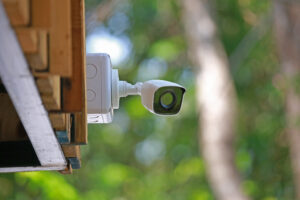How To Pick The Best Security Cameras For Your New Home In 7 Easy Steps

It is not hard to come across good security cameras these days. There are small ones that can barely be seen or hidden in the peephole of a door, there are big ones that can track all around them, and there are both remote and wired cameras for different levels of cyber security.
But all the diversity of security cameras ultimately means that picking a security camera is not about picking the best security camera. It is about picking the right security camera for you.
So, let’s go over a surefire method of how to pick the right security camera.
Consider Your Existing Security System
The best thing you can do for a first step is look at the security systems you already have in place. Do you have an alarm? Did it come with motion sensors? Can you control them?
If not, then that means that the security camera is going to be the first security element in your home’s security system. That will mean that your cameras will need more accessories with them, such as their own motion sensors, and possibly data cables for connecting to devices.
Basically, you do not need a camera or multiple cameras to cover that which is already taken care of by an already existing security system. Be careful about overlapping them.
Get a Camera with an App
This is possibly the most important step. People imagine security cameras as being connected to computers or security rooms. They think a security camera has to back up every moment of the day it records. But those are not the kinds of security cameras you will want to get.
For as new home you are going to want to get something that can be controlled with an app. This will also guarantee that it will be able to connect to motion sensors too.
An app will also allow you to get a notification when your cameras are triggered. Some apps even let you watch a live feed of the cameras, though this is considerably less necessary.
Perhaps most importantly, an app is where you control the protocols of what your cameras do and when they do it, as well as how much they can do remotely. Do they record? Take pictures? Send notifications? And do they do these things at will, or just when they are triggered?
Your cameras should support an app, but what the app does depends on your preference.
Find the Vulnerabilities in Your Home
You can determine the vulnerabilities of your home by looking at its entrances and its potential entrances. That means the front and the back door, the garage, and the windows.
Count these entrances and get an idea of how many are on each side of your home. If your home has a lot of verticality, then you can place the cameras higher up and point them downwards. You do not need them cameras to look up all that much.
The number of vulnerabilities in your home will also determine how many motion sensors you need.
Try to Find Where Your Vulnerabilities are Most Visible
What you are looking for is where you can stand so that you can see all of the doors and windows on one side of the house. We mentioned earlier that some cameras can see all around them. These cameras are usually used for surveilling places like malls and banks.
The cameras you want for a home will be focused on one direction. The width of their lenses is determined by how large your home is, but you probably don’t need any camera with more than 100 degrees of field of view.
Where your home’s vulnerabilities are most visible is where you will put your cameras. It does not need to be where you place your motion sensors, however.
Find the Shortest Paths into Your Home
Once you know where the vulnerabilities are, you can place the motion sensors we mentioned earlier. The idea is that you place them near the vulnerabilities. That can mean placing them right next to a door or in front of a window. Just be sure not to place them too close.
Part of what you are doing by setting up motion sensors is trying to capture people that break into your house on camera. The motion sensors should trigger the camera to record.
That means if you want your cameras to be as responsive as possible, then you will want to place the motion sensors a little apart from your doors and windows. That means they do not activate right at the moment the intruder breaks into your home, but shortly before.
Hard Wired vs. Wireless
This is one of the most important decisions to make. Wired cameras have to be set up near your house, but they do not have a battery life. Wireless cameras are more vulnerable to cyber attacks, but more versatile. Generally speaking, we recommend wireless cameras.
The issue with wired cameras is that while a camera with a battery seems unreliable, most batteries can actually last quite a long time now. Wired cameras can have their wires cut, however.
Pick a Camera that is Easy to Set Up
While no one likes to admit it, most people are not security experts. That means that for all of the cameras, motion sensors, and apps you have access to, you might only be able to set up half of them without issue. Pick security cameras that are smaller and come with their own systems for being hung up and staying up. Trying to get creative will cost you.
Conclusion
Getting the right camera for your home means knowing your home inside and out. But if you know how your home is vulnerable and know what your technological limitations are, then you can make a few easy decisions as to what kind of cameras you need and how many you need.




